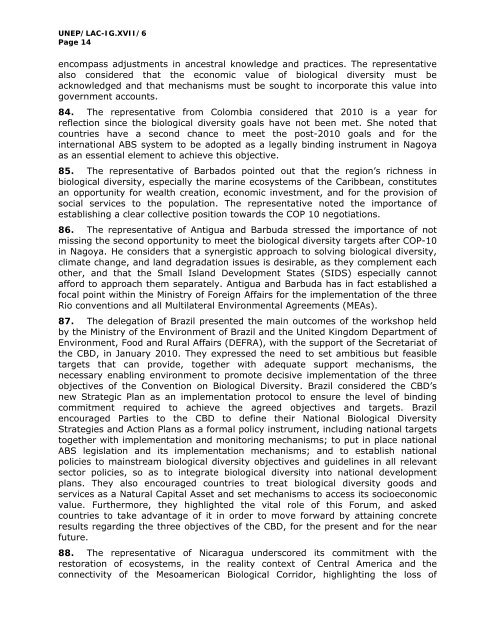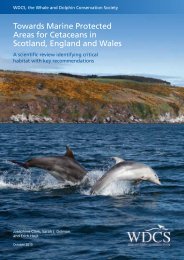English - Programa de Naciones Unidas para el Medio Ambiente
English - Programa de Naciones Unidas para el Medio Ambiente
English - Programa de Naciones Unidas para el Medio Ambiente
- No tags were found...
You also want an ePaper? Increase the reach of your titles
YUMPU automatically turns print PDFs into web optimized ePapers that Google loves.
UNEP/LAC-IG.XVII/6Page 14encompass adjustments in ancestral knowledge and practices. The representativealso consi<strong>de</strong>red that the economic value of biological diversity must beacknowledged and that mechanisms must be sought to incorporate this value intogovernment accounts.84. The representative from Colombia consi<strong>de</strong>red that 2010 is a year forreflection since the biological diversity goals have not been met. She noted thatcountries have a second chance to meet the post-2010 goals and for theinternational ABS system to be adopted as a legally binding instrument in Nagoyaas an essential <strong>el</strong>ement to achieve this objective.85. The representative of Barbados pointed out that the region’s richness inbiological diversity, especially the marine ecosystems of the Caribbean, constitutesan opportunity for wealth creation, economic investment, and for the provision ofsocial services to the population. The representative noted the importance ofestablishing a clear collective position towards the COP 10 negotiations.86. The representative of Antigua and Barbuda stressed the importance of notmissing the second opportunity to meet the biological diversity targets after COP-10in Nagoya. He consi<strong>de</strong>rs that a synergistic approach to solving biological diversity,climate change, and land <strong>de</strong>gradation issues is <strong>de</strong>sirable, as they complement eachother, and that the Small Island Dev<strong>el</strong>opment States (SIDS) especially cannotafford to approach them se<strong>para</strong>t<strong>el</strong>y. Antigua and Barbuda has in fact established afocal point within the Ministry of Foreign Affairs for the implementation of the threeRio conventions and all Multilateral Environmental Agreements (MEAs).87. The <strong>de</strong>legation of Brazil presented the main outcomes of the workshop h<strong>el</strong>dby the Ministry of the Environment of Brazil and the United Kingdom Department ofEnvironment, Food and Rural Affairs (DEFRA), with the support of the Secretariat ofthe CBD, in January 2010. They expressed the need to set ambitious but feasibletargets that can provi<strong>de</strong>, together with a<strong>de</strong>quate support mechanisms, thenecessary enabling environment to promote <strong>de</strong>cisive implementation of the threeobjectives of the Convention on Biological Diversity. Brazil consi<strong>de</strong>red the CBD’snew Strategic Plan as an implementation protocol to ensure the lev<strong>el</strong> of bindingcommitment required to achieve the agreed objectives and targets. Brazilencouraged Parties to the CBD to <strong>de</strong>fine their National Biological DiversityStrategies and Action Plans as a formal policy instrument, including national targetstogether with implementation and monitoring mechanisms; to put in place nationalABS legislation and its implementation mechanisms; and to establish nationalpolicies to mainstream biological diversity objectives and gui<strong>de</strong>lines in all r<strong>el</strong>evantsector policies, so as to integrate biological diversity into national <strong>de</strong>v<strong>el</strong>opmentplans. They also encouraged countries to treat biological diversity goods andservices as a Natural Capital Asset and set mechanisms to access its socioeconomicvalue. Furthermore, they highlighted the vital role of this Forum, and askedcountries to take advantage of it in or<strong>de</strong>r to move forward by attaining concreteresults regarding the three objectives of the CBD, for the present and for the nearfuture.88. The representative of Nicaragua un<strong>de</strong>rscored its commitment with therestoration of ecosystems, in the reality context of Central America and theconnectivity of the Mesoamerican Biological Corridor, highlighting the loss of
















